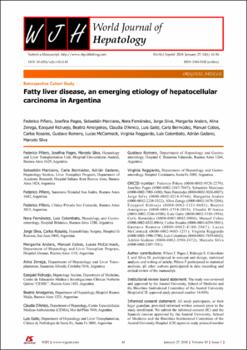| dc.description.abstract | AIM:
To investigate any changing trends in the etiologies of hepatocellular carcinoma (HCC) in Argentina during the last years.
METHODS:
A longitudinal cohort study was conducted by 14 regional hospitals starting in 2009 through 2016. All adult patients with newly diagnosed HCC either with pathology or imaging criteria were included. Patients were classified as presenting non-alcoholic fatty liver disease (NAFLD) either by histology or clinically, provided that all other etiologies of liver disease were ruled out, fatty liver was present on abdominal ultrasound and alcohol consumption was excluded. Complete follow-up was assessed in all included subjects since the date of HCC diagnosis until death or last medical visit.
RESULTS:
A total of 708 consecutive adults with HCC were included. Six out of 14 hospitals were liver transplant centers (n = 484). The prevalence of diabetes mellitus was 27.7%. Overall, HCV was the main cause of liver disease related with HCC (37%) including cirrhotic and non-cirrhotic patients, followed by alcoholic liver disease 20.8%, NAFLD 11.4%, cryptogenic 9.6%, HBV 5.4% infection, cholestatic disease and autoimmune hepatitis 2.2%, and other causes 9.9%. A 6-fold increase in the percentage corresponding to NAFLD-HCC was detected when the starting year, i.e., 2009 was compared to the last one, i.e., 2015 (4.3% vs 25.6%; P < 0.0001). Accordingly, a higher prevalence of diabetes mellitus was present in NAFLD-HCC group 61.7% when compared to other than NAFLD-HCC 23.3% (P < 0.0001). Lower median AFP values at HCC diagnosis were observed between NAFLD-HCC and non-NAFLD groups (6.6 ng/mL vs 26 ng/mL; P = 0.02). Neither NAFLD nor other HCC etiologies were associated with higher mortality.
CONCLUSION:
The growing incidence of NAFLD-HCC documented in the United States and Europe is also observed in Argentina, a confirmation with important Public Health implications. | en_US |


